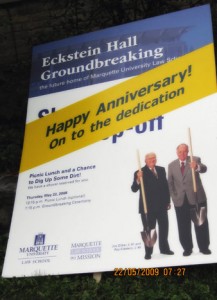MULS 2009 Works-In-Progress Workshop (June Session)
 To open my month as faculty blogger, I would first like to thank my colleague Michael O’Hear, whose dedication to, and work for, the Marquette Faculty Blog since its creation last summer have been incredible. This is very much one of the major reasons why this project has been so successful and brought so many wonderful contributions to so many aspects of the law so far.
To open my month as faculty blogger, I would first like to thank my colleague Michael O’Hear, whose dedication to, and work for, the Marquette Faculty Blog since its creation last summer have been incredible. This is very much one of the major reasons why this project has been so successful and brought so many wonderful contributions to so many aspects of the law so far.
Another fundamental area where the Marquette Law School faculty is also showing important contributions to the law is the production of scholarship that results in law review articles, book chapters, textbooks, etc. We often present and discuss these works when they are still in progress in conferences around the country with our colleagues in our areas at other schools. Still, to facilitate even further these very important discussions, the MULS Academic Programs Committee, led by Professor Chad Oldfather, has organized two sessions of an in-house Works-in-Progress Workshop for June and July.
The June session was a great success. A group of eight of us met this past Wednesday and presented our works-in-progress, from very rough to more completed drafts of scholarship, to our colleagues participating in the program.

